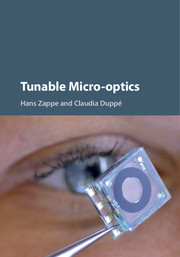Book contents
- Frontmatter
- Dedication
- Contents
- List of contributors
- List of acronyms
- Part I Introduction
- Part II Devices and materials
- Part III Systems and Applications
- 11 Characterization of Micro-optics
- 12 Photonic Crystals
- 13 MEMS Scanners for OCT Applications
- 14 Liquid Crystal Elastomer Micro-optics
- 15 Adaptive Scanning Micro-eye
- 16 Hyperspectral Eye
- 17 Plenoptic Cameras
- Index
- References
16 - Hyperspectral Eye
from Part III - Systems and Applications
Published online by Cambridge University Press: 05 December 2015
- Frontmatter
- Dedication
- Contents
- List of contributors
- List of acronyms
- Part I Introduction
- Part II Devices and materials
- Part III Systems and Applications
- 11 Characterization of Micro-optics
- 12 Photonic Crystals
- 13 MEMS Scanners for OCT Applications
- 14 Liquid Crystal Elastomer Micro-optics
- 15 Adaptive Scanning Micro-eye
- 16 Hyperspectral Eye
- 17 Plenoptic Cameras
- Index
- References
Summary
Hyperspectral Imaging
The exceptional vision capabilities of the mantis shrimp have inspired us to design a new system for hyperspectral imaging. Beyond the natural model, the introduced system allows us to select between two modes: one for pure imaging and a second for line-wise spectral analysis. Thus, in order to assure a compact system providing high image quality, our approach is to use an adaptive lens, on the one hand, and “saccade type” movements of the imaging unit on the other. To change from the imaging into the spectral mode, a variable grating has to be switched active, and a slit aperture has to be closed and scanned. A reliable, compact hyperspectral image camera will be a valuable tool wherever spectral information is needed, such as in quality control of industrial production or in the agri-food industry.
The Natural Model
Hyperspectral imaging combines lateral imaging with spectroscopy and provides a wavelength resolved measurement for each image pixel. The perception of colors in the surrounding environment offers a wide range of additional information compared to simple dark and bright intensity measurements. In nature, various selective color detection systems evolved over millions of years to discriminate between the different wavelengths, whereas the specific implementation varies significantly in the animal world. Many mammals, such as cats, dogs, and horses, have only two color receptor types; humans and bees have three; many birds and fish have four; and some butterflies possess up to eight different color receptors (Koshitaka et al. 2008).
With twelve color receptors, the mantis shrimp could be called the world champion in this field. This marine crustacean, hunts for prey such as snails, crabs, or molluscs by spearing or smashing them at high speed with its exceptional striking claws. The mantis shrimp possesses compound eyes of the apposition type, which are stalk-mounted and can thus be moved independently from one another. Figure 16.1 shows a close-up of the shrimp's eyes.
Each of the mantis shrimp's eyes is composed of an upper and a lower hemisphere that are separated from each other by a mid-band. The mid-band region is made up of six rows, and contains sixteen different light receptors, twelve of which are used to differentiate color and four to distinguish various polarization states (Cronin & Marshall 2001, Land & Nilsson 2012, Land et al. 1990, Marshall & Oberwinkler 1999).
- Type
- Chapter
- Information
- Tunable Micro-optics , pp. 395 - 416Publisher: Cambridge University PressPrint publication year: 2015



